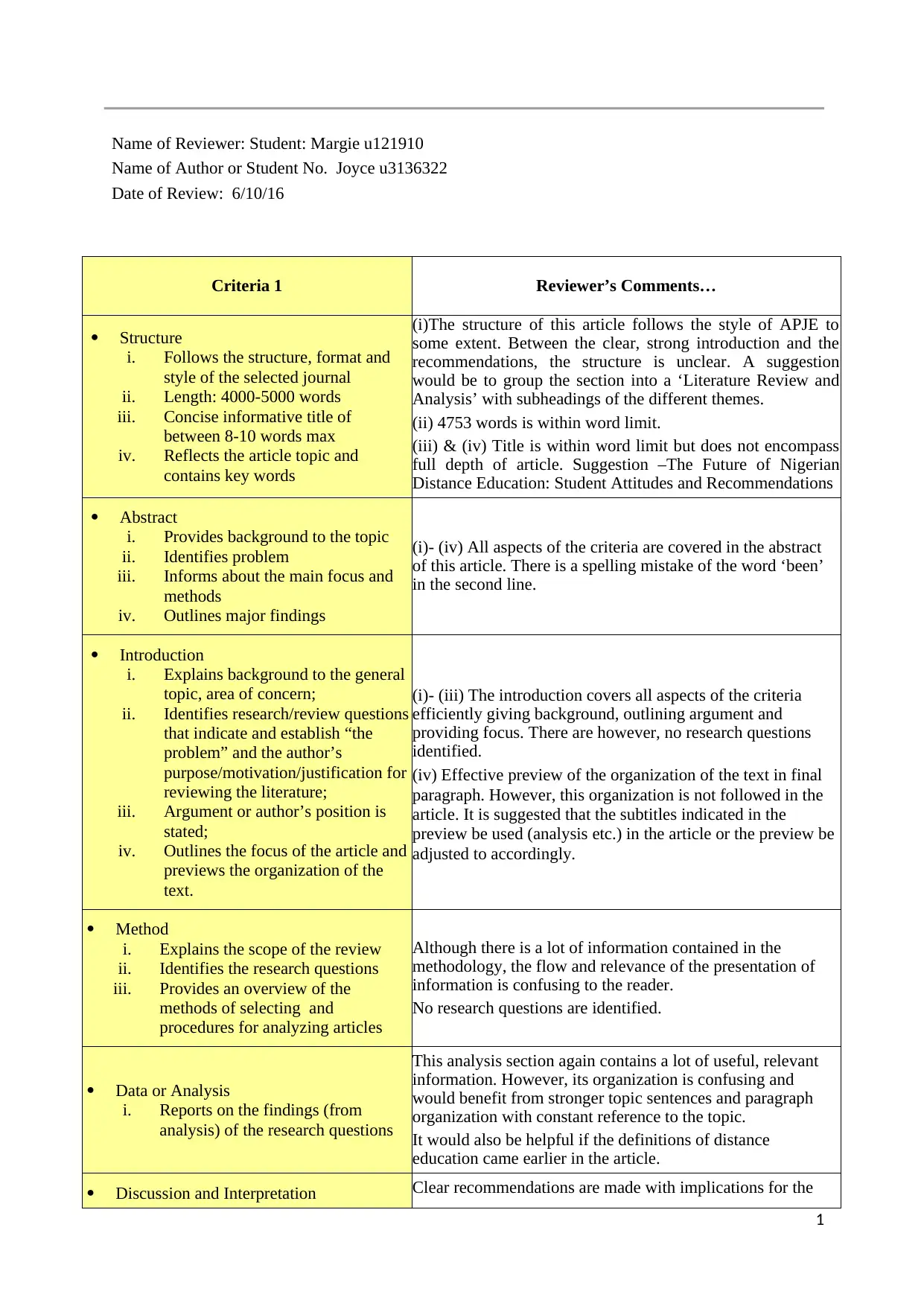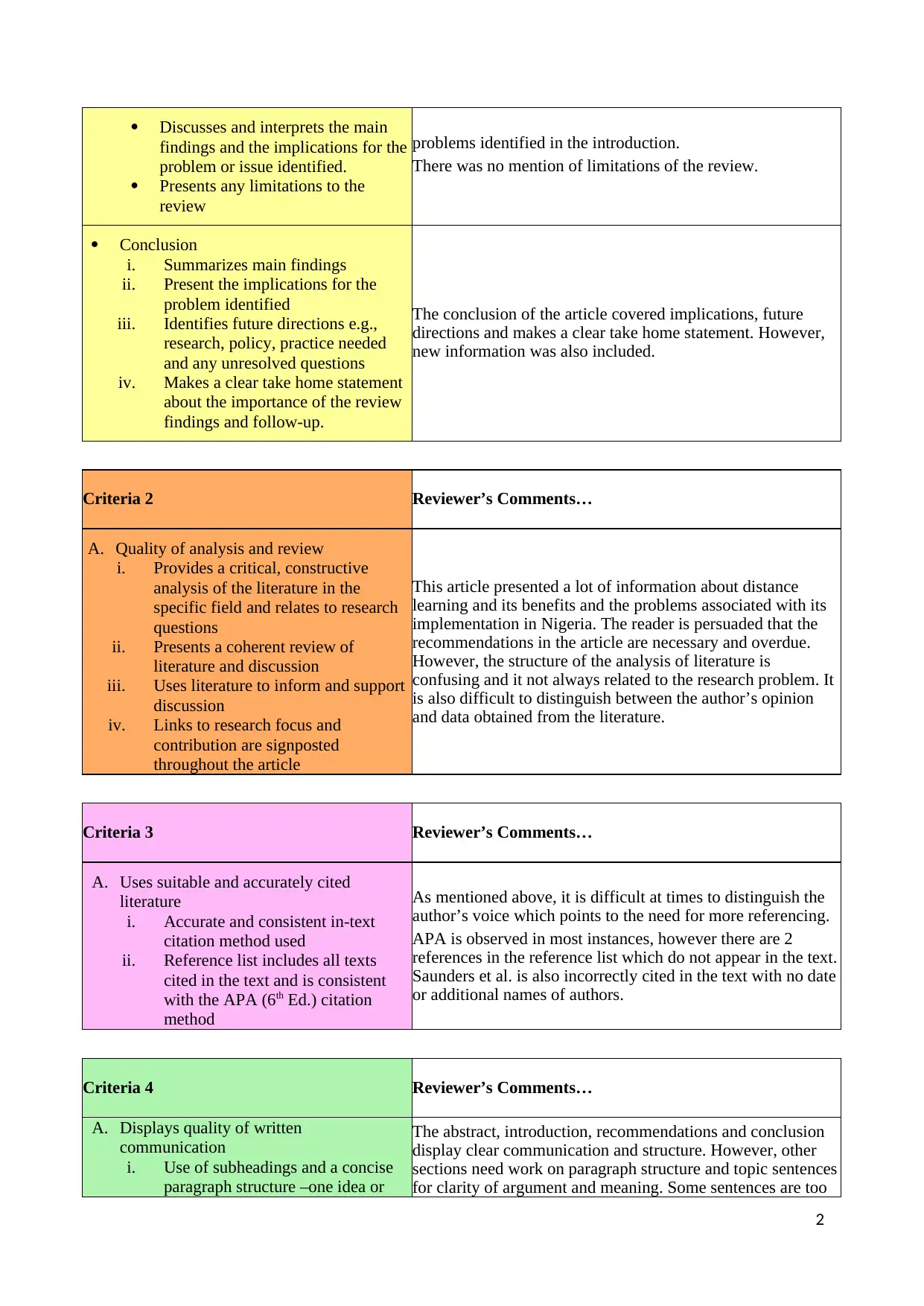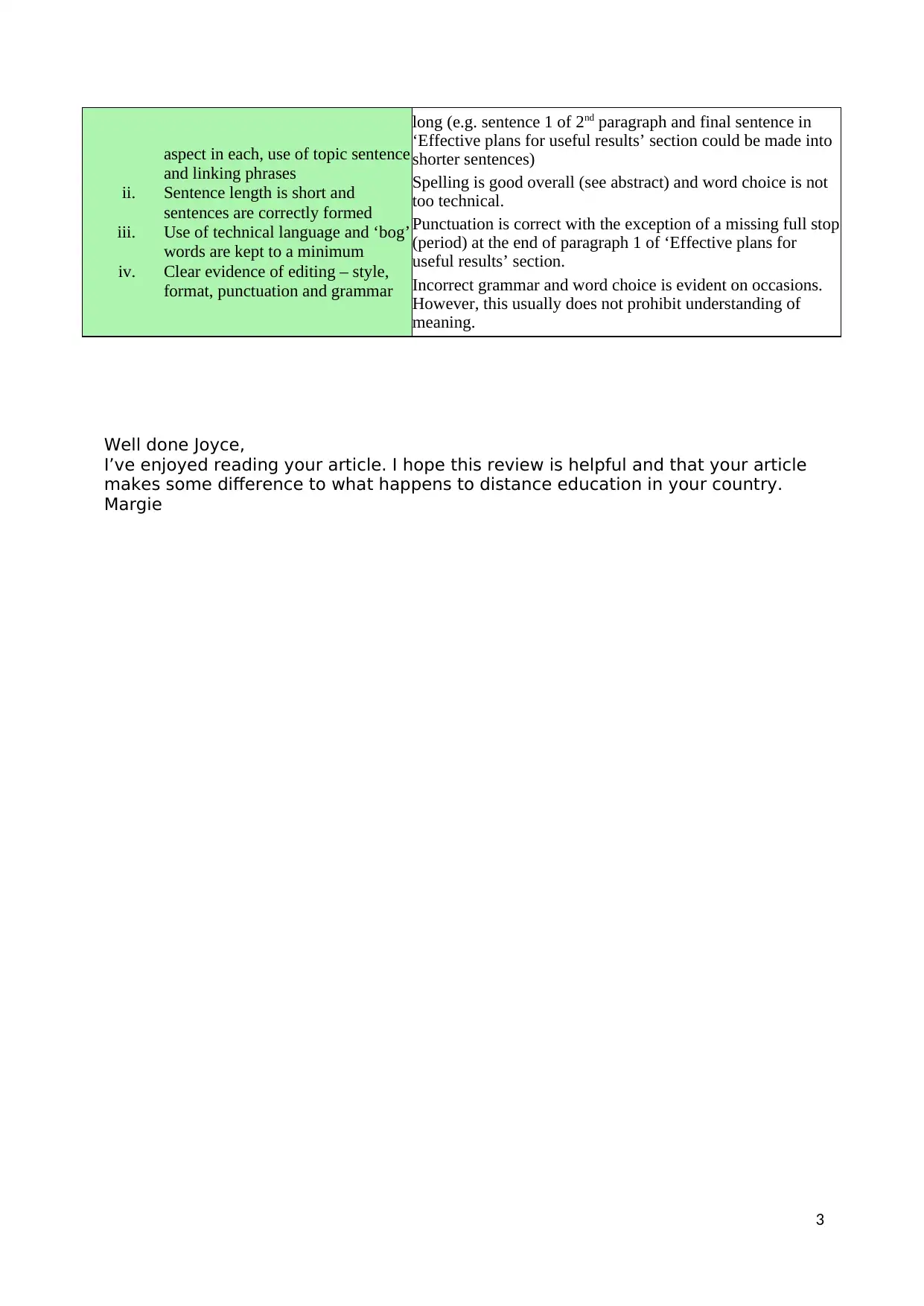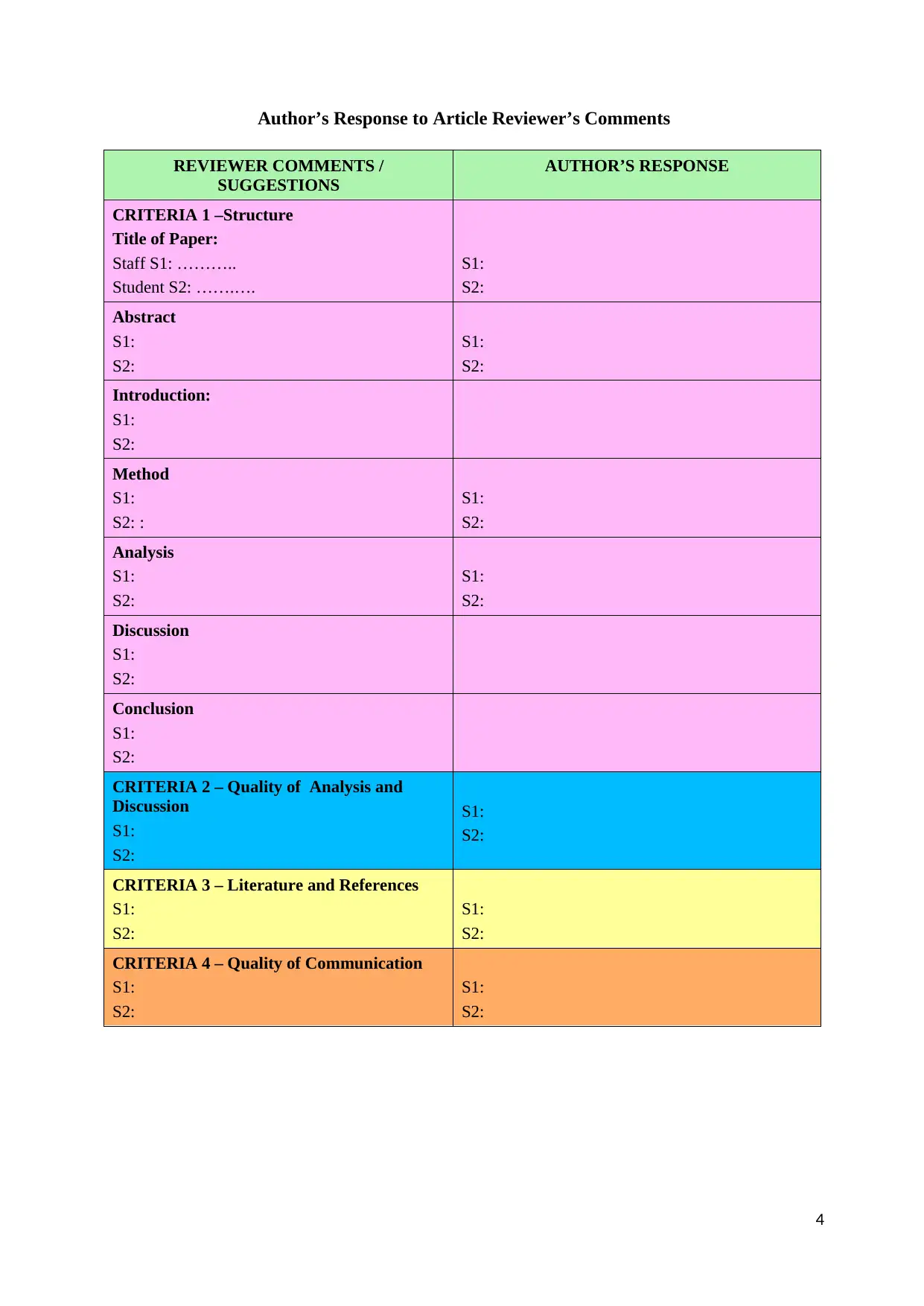Article Review: Student Attitudes Towards Nigerian Distance Education
VerifiedAdded on 2019/10/16
|4
|1206
|491
Report
AI Summary
This document presents a detailed review of an article focusing on distance education in Nigeria. The review, conducted by Margie, evaluates the structure, quality of analysis, literature usage, and written communication of the article authored by Joyce. The review highlights strengths such as adherence to the journal's format and a clear conclusion with recommendations. However, it also points out weaknesses, including an unclear structure in certain sections, confusing organization of the analysis, and inconsistencies in referencing. The reviewer provides specific suggestions for improvement, such as grouping sections under subheadings, clarifying the flow of information, strengthening topic sentences, and ensuring consistent referencing. The review also includes the author's responses to the reviewer's comments, offering a comprehensive analysis of the article's strengths and areas needing improvement, ultimately aiming to enhance the quality and impact of the article on distance education in Nigeria.

Name of Reviewer: Student: Margie u121910
Name of Author or Student No. Joyce u3136322
Date of Review: 6/10/16
Criteria 1 Reviewer’s Comments…
Structure
i. Follows the structure, format and
style of the selected journal
ii. Length: 4000-5000 words
iii. Concise informative title of
between 8-10 words max
iv. Reflects the article topic and
contains key words
(i)The structure of this article follows the style of APJE to
some extent. Between the clear, strong introduction and the
recommendations, the structure is unclear. A suggestion
would be to group the section into a ‘Literature Review and
Analysis’ with subheadings of the different themes.
(ii) 4753 words is within word limit.
(iii) & (iv) Title is within word limit but does not encompass
full depth of article. Suggestion –The Future of Nigerian
Distance Education: Student Attitudes and Recommendations
Abstract
i. Provides background to the topic
ii. Identifies problem
iii. Informs about the main focus and
methods
iv. Outlines major findings
(i)- (iv) All aspects of the criteria are covered in the abstract
of this article. There is a spelling mistake of the word ‘been’
in the second line.
Introduction
i. Explains background to the general
topic, area of concern;
ii. Identifies research/review questions
that indicate and establish “the
problem” and the author’s
purpose/motivation/justification for
reviewing the literature;
iii. Argument or author’s position is
stated;
iv. Outlines the focus of the article and
previews the organization of the
text.
(i)- (iii) The introduction covers all aspects of the criteria
efficiently giving background, outlining argument and
providing focus. There are however, no research questions
identified.
(iv) Effective preview of the organization of the text in final
paragraph. However, this organization is not followed in the
article. It is suggested that the subtitles indicated in the
preview be used (analysis etc.) in the article or the preview be
adjusted to accordingly.
Method
i. Explains the scope of the review
ii. Identifies the research questions
iii. Provides an overview of the
methods of selecting and
procedures for analyzing articles
Although there is a lot of information contained in the
methodology, the flow and relevance of the presentation of
information is confusing to the reader.
No research questions are identified.
Data or Analysis
i. Reports on the findings (from
analysis) of the research questions
This analysis section again contains a lot of useful, relevant
information. However, its organization is confusing and
would benefit from stronger topic sentences and paragraph
organization with constant reference to the topic.
It would also be helpful if the definitions of distance
education came earlier in the article.
Discussion and Interpretation Clear recommendations are made with implications for the
1
Name of Author or Student No. Joyce u3136322
Date of Review: 6/10/16
Criteria 1 Reviewer’s Comments…
Structure
i. Follows the structure, format and
style of the selected journal
ii. Length: 4000-5000 words
iii. Concise informative title of
between 8-10 words max
iv. Reflects the article topic and
contains key words
(i)The structure of this article follows the style of APJE to
some extent. Between the clear, strong introduction and the
recommendations, the structure is unclear. A suggestion
would be to group the section into a ‘Literature Review and
Analysis’ with subheadings of the different themes.
(ii) 4753 words is within word limit.
(iii) & (iv) Title is within word limit but does not encompass
full depth of article. Suggestion –The Future of Nigerian
Distance Education: Student Attitudes and Recommendations
Abstract
i. Provides background to the topic
ii. Identifies problem
iii. Informs about the main focus and
methods
iv. Outlines major findings
(i)- (iv) All aspects of the criteria are covered in the abstract
of this article. There is a spelling mistake of the word ‘been’
in the second line.
Introduction
i. Explains background to the general
topic, area of concern;
ii. Identifies research/review questions
that indicate and establish “the
problem” and the author’s
purpose/motivation/justification for
reviewing the literature;
iii. Argument or author’s position is
stated;
iv. Outlines the focus of the article and
previews the organization of the
text.
(i)- (iii) The introduction covers all aspects of the criteria
efficiently giving background, outlining argument and
providing focus. There are however, no research questions
identified.
(iv) Effective preview of the organization of the text in final
paragraph. However, this organization is not followed in the
article. It is suggested that the subtitles indicated in the
preview be used (analysis etc.) in the article or the preview be
adjusted to accordingly.
Method
i. Explains the scope of the review
ii. Identifies the research questions
iii. Provides an overview of the
methods of selecting and
procedures for analyzing articles
Although there is a lot of information contained in the
methodology, the flow and relevance of the presentation of
information is confusing to the reader.
No research questions are identified.
Data or Analysis
i. Reports on the findings (from
analysis) of the research questions
This analysis section again contains a lot of useful, relevant
information. However, its organization is confusing and
would benefit from stronger topic sentences and paragraph
organization with constant reference to the topic.
It would also be helpful if the definitions of distance
education came earlier in the article.
Discussion and Interpretation Clear recommendations are made with implications for the
1
Paraphrase This Document
Need a fresh take? Get an instant paraphrase of this document with our AI Paraphraser

Discusses and interprets the main
findings and the implications for the
problem or issue identified.
Presents any limitations to the
review
problems identified in the introduction.
There was no mention of limitations of the review.
Conclusion
i. Summarizes main findings
ii. Present the implications for the
problem identified
iii. Identifies future directions e.g.,
research, policy, practice needed
and any unresolved questions
iv. Makes a clear take home statement
about the importance of the review
findings and follow-up.
The conclusion of the article covered implications, future
directions and makes a clear take home statement. However,
new information was also included.
Criteria 2 Reviewer’s Comments…
A. Quality of analysis and review
i. Provides a critical, constructive
analysis of the literature in the
specific field and relates to research
questions
ii. Presents a coherent review of
literature and discussion
iii. Uses literature to inform and support
discussion
iv. Links to research focus and
contribution are signposted
throughout the article
This article presented a lot of information about distance
learning and its benefits and the problems associated with its
implementation in Nigeria. The reader is persuaded that the
recommendations in the article are necessary and overdue.
However, the structure of the analysis of literature is
confusing and it not always related to the research problem. It
is also difficult to distinguish between the author’s opinion
and data obtained from the literature.
Criteria 3 Reviewer’s Comments…
A. Uses suitable and accurately cited
literature
i. Accurate and consistent in-text
citation method used
ii. Reference list includes all texts
cited in the text and is consistent
with the APA (6th Ed.) citation
method
As mentioned above, it is difficult at times to distinguish the
author’s voice which points to the need for more referencing.
APA is observed in most instances, however there are 2
references in the reference list which do not appear in the text.
Saunders et al. is also incorrectly cited in the text with no date
or additional names of authors.
Criteria 4 Reviewer’s Comments…
A. Displays quality of written
communication
i. Use of subheadings and a concise
paragraph structure –one idea or
The abstract, introduction, recommendations and conclusion
display clear communication and structure. However, other
sections need work on paragraph structure and topic sentences
for clarity of argument and meaning. Some sentences are too
2
findings and the implications for the
problem or issue identified.
Presents any limitations to the
review
problems identified in the introduction.
There was no mention of limitations of the review.
Conclusion
i. Summarizes main findings
ii. Present the implications for the
problem identified
iii. Identifies future directions e.g.,
research, policy, practice needed
and any unresolved questions
iv. Makes a clear take home statement
about the importance of the review
findings and follow-up.
The conclusion of the article covered implications, future
directions and makes a clear take home statement. However,
new information was also included.
Criteria 2 Reviewer’s Comments…
A. Quality of analysis and review
i. Provides a critical, constructive
analysis of the literature in the
specific field and relates to research
questions
ii. Presents a coherent review of
literature and discussion
iii. Uses literature to inform and support
discussion
iv. Links to research focus and
contribution are signposted
throughout the article
This article presented a lot of information about distance
learning and its benefits and the problems associated with its
implementation in Nigeria. The reader is persuaded that the
recommendations in the article are necessary and overdue.
However, the structure of the analysis of literature is
confusing and it not always related to the research problem. It
is also difficult to distinguish between the author’s opinion
and data obtained from the literature.
Criteria 3 Reviewer’s Comments…
A. Uses suitable and accurately cited
literature
i. Accurate and consistent in-text
citation method used
ii. Reference list includes all texts
cited in the text and is consistent
with the APA (6th Ed.) citation
method
As mentioned above, it is difficult at times to distinguish the
author’s voice which points to the need for more referencing.
APA is observed in most instances, however there are 2
references in the reference list which do not appear in the text.
Saunders et al. is also incorrectly cited in the text with no date
or additional names of authors.
Criteria 4 Reviewer’s Comments…
A. Displays quality of written
communication
i. Use of subheadings and a concise
paragraph structure –one idea or
The abstract, introduction, recommendations and conclusion
display clear communication and structure. However, other
sections need work on paragraph structure and topic sentences
for clarity of argument and meaning. Some sentences are too
2

aspect in each, use of topic sentence
and linking phrases
ii. Sentence length is short and
sentences are correctly formed
iii. Use of technical language and ‘bog’
words are kept to a minimum
iv. Clear evidence of editing – style,
format, punctuation and grammar
long (e.g. sentence 1 of 2nd paragraph and final sentence in
‘Effective plans for useful results’ section could be made into
shorter sentences)
Spelling is good overall (see abstract) and word choice is not
too technical.
Punctuation is correct with the exception of a missing full stop
(period) at the end of paragraph 1 of ‘Effective plans for
useful results’ section.
Incorrect grammar and word choice is evident on occasions.
However, this usually does not prohibit understanding of
meaning.
Well done Joyce,
I’ve enjoyed reading your article. I hope this review is helpful and that your article
makes some difference to what happens to distance education in your country.
Margie
3
and linking phrases
ii. Sentence length is short and
sentences are correctly formed
iii. Use of technical language and ‘bog’
words are kept to a minimum
iv. Clear evidence of editing – style,
format, punctuation and grammar
long (e.g. sentence 1 of 2nd paragraph and final sentence in
‘Effective plans for useful results’ section could be made into
shorter sentences)
Spelling is good overall (see abstract) and word choice is not
too technical.
Punctuation is correct with the exception of a missing full stop
(period) at the end of paragraph 1 of ‘Effective plans for
useful results’ section.
Incorrect grammar and word choice is evident on occasions.
However, this usually does not prohibit understanding of
meaning.
Well done Joyce,
I’ve enjoyed reading your article. I hope this review is helpful and that your article
makes some difference to what happens to distance education in your country.
Margie
3
⊘ This is a preview!⊘
Do you want full access?
Subscribe today to unlock all pages.

Trusted by 1+ million students worldwide

Author’s Response to Article Reviewer’s Comments
REVIEWER COMMENTS /
SUGGESTIONS
AUTHOR’S RESPONSE
CRITERIA 1 –Structure
Title of Paper:
Staff S1: ………..
Student S2: …….….
S1:
S2:
Abstract
S1:
S2:
S1:
S2:
Introduction:
S1:
S2:
Method
S1:
S2: :
S1:
S2:
Analysis
S1:
S2:
S1:
S2:
Discussion
S1:
S2:
Conclusion
S1:
S2:
CRITERIA 2 – Quality of Analysis and
Discussion
S1:
S2:
S1:
S2:
CRITERIA 3 – Literature and References
S1:
S2:
S1:
S2:
CRITERIA 4 – Quality of Communication
S1:
S2:
S1:
S2:
4
REVIEWER COMMENTS /
SUGGESTIONS
AUTHOR’S RESPONSE
CRITERIA 1 –Structure
Title of Paper:
Staff S1: ………..
Student S2: …….….
S1:
S2:
Abstract
S1:
S2:
S1:
S2:
Introduction:
S1:
S2:
Method
S1:
S2: :
S1:
S2:
Analysis
S1:
S2:
S1:
S2:
Discussion
S1:
S2:
Conclusion
S1:
S2:
CRITERIA 2 – Quality of Analysis and
Discussion
S1:
S2:
S1:
S2:
CRITERIA 3 – Literature and References
S1:
S2:
S1:
S2:
CRITERIA 4 – Quality of Communication
S1:
S2:
S1:
S2:
4
1 out of 4
Related Documents
Your All-in-One AI-Powered Toolkit for Academic Success.
+13062052269
info@desklib.com
Available 24*7 on WhatsApp / Email
![[object Object]](/_next/static/media/star-bottom.7253800d.svg)
Unlock your academic potential
Copyright © 2020–2025 A2Z Services. All Rights Reserved. Developed and managed by ZUCOL.





